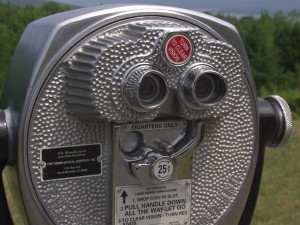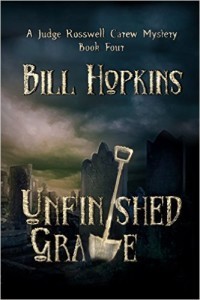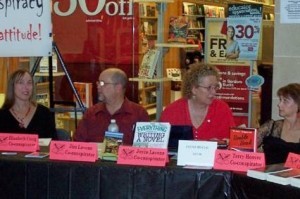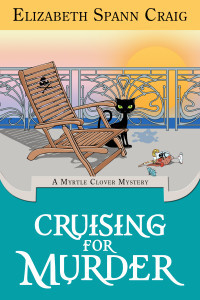Elizabeth Spann Craig's Blog, page 113
November 5, 2015
Getting Feedback and Being Part of a Community
by Elizabeth S. Craig, @elizabethscraig
Self-published writers frequently hear that they need to pass their books by beta readers or critique groups first before sending the stories on to freelance editors (fewer corrections in a book means a less expensive editing process).
Some writers never even get as far as needing a beta reader because they didn’t seek out encouragement and support from the writing community.
But sometimes it can be tough to know exactly where to find these beta readers and online support. Here are a few ideas.
First Readers/Beta Readers
Online critique groups and beta readers. Sometimes I think we can run into the same problem that we can with in-person crit groups…we might be much better or much worse than our crit partner. But we also have more of a selection to choose from in terms of writer experience.
There are resources to help you connect:
Jane Friedman’s guest poster Brooke McIntyre has a nice list of places to connect with beta readers or critique groups.
Cathy Yardley from The Write Life has 40 places to find a critique partner.
In-person critique/writer groups. I found that critique groups could be tricky, at least the in-person kind. It’s sort of like playing tennis…if you play with someone much better than you, or much worse than you, you don’t get a lot out of it. What I did like was being around other writers and receiving support and encouragement. But eventually, I did drop out of all my in-person groups. Apparently, I’m just too introverted.
I do know of writers who have found some success using MeetUp as a way to mix with local writers.
Wattpad. Wattpad is a good way to test your story on an audience. But to get the most out of the experience, we should plan on uploading the full story. This can mean either serial writing or serial publishing. We can take our story down at any time, so having the completed book free on Wattpad won’t sabotage our efforts to publish it later on.
I enjoy the feedback that I’ve gotten on my stories on the site. But I do think it would be especially helpful if we’d written a YA book since that’s the primary audience (teens) on Wattpad. If you want to find out if you’re nailing the voice of that age group, this would be a good place to try it out.
Help from fans. This would be for the more established writer. Yes, we need help with our drafts, too. I really dislike the term fan when it’s used to describe readers. I think of my readers as readers, not fans. But! There are some readers that definitely qualify as fans and even I can’t ignore that. One of mine in particular follows one of my series so closely that I feel she knows my characters better than I do. She’s my biggest supporter and my biggest critic when I haven’t hit the mark. Instead of reading her (very insightful) criticism when I hadn’t done as well in a book, I enlisted her support as a beta reader before publishing. Now I email her a copy of my book before publishing and use her comments to make adjustments before the launch.
Support from the Community:
#NaNoWriMo. No matter what people say about NaNoWriMo (it’s usually that it produces a very rushed product), I do feel that it can help some writers to develop a writing habit and force them to finally move forward with writing a novel.
If you can write 50,000 words in November, I think that’s fantastic. No one is saying that you have to immediately publish that book. I’ve certainly written that much before (on my own, not as part of NaNoWriMo…under deadline pressure), and I was able to fix the manuscript fairly quickly (I’m practiced at self-editing) and then send it out to my editor. It sold well, too. This doesn’t work for everyone and I don’t think that feeling of pressure works for everyone. There are writers out there who are slow writers, thoughtful writers, and NaNo is the wrong thing for them to do. But if you’ve wanted to write a novel for years and have procrastinated writing it, the encouragement from that community and the marking-down of the daily count can jumpstart your book.
For the first time ever I’ve signed up. But because I’m guilty of horrendous cheating, I haven’t put my name to it. I’m starting out with a novel that’s halfway finished. I decided, though, that I wanted to track my progress using NaNo’s cool charts and word count trackers. November looks to be busy for me (college kid coming home, horseback shows, daughter’s extracurriculars, public speaking for me), so I think this may help me not just keep on track but actually get ahead.
#IWSG. The Insecure Writers Support Group formed by Alex J. Cavanaugh. Being a writer can be an isolating experience. This free community offers writing tips and resources for everything from freelance writing to novel writing. Resources include information on writing contests, conferences, and courses for writers. And there is a monthly blog hop devoted to outlining struggles and successes that members have faced.
How do you find feedback on your books and support for writing them?
Tips for getting feedback and finding an online community:
Click To Tweet
Image: MorgueFile: LadyHeart
The post Getting Feedback and Being Part of a Community appeared first on Elizabeth Spann Craig.
November 1, 2015
Trying New Things for More Visibility
By Elizabeth S. Craig, @elizabethscraig
 OLYMPUS DIGITAL CAMERA
OLYMPUS DIGITAL CAMERAThe business side of writing seems to take more and more time.
If I knock out my writing goal first, though, I don’t have that uncomfortable sense of being conflicted. And I remind myself that whatever time I spend putting my content “out there” should be repaid later on by sales. Hopefully.
AmazonCrossing. Although I think there is still a huge untapped English-speaking or ESL audience out there in the digital reading market, I’ll admit to an interest in translation. After all, if I want to relax with a good book, I sure as heck want to read it in English. Reading it in French (my high school and college foreign language) would be a struggle and certainly not as relaxing.
AmazonCrossing is the arm of the retailer that’s working on projects for translation. I pitched them a book and am waiting on a reply. We’ll see. I have a feeling it’s tricky to get in.
Fiberead. More translation opportunities. This one is for Chinese language translation. The process appears to be a long one here, but I’ve got a project manager for one book that I’m hoping to get translated and uploaded to Chinese retailers.
YouTube. Recently, I’ve definitely been courting the young people. I’m on Wattpad (see below) and even had a guest post for a millennial book blogger (Richard Denney) with a YouTube channel to try to stir up interest in cozy mysteries for younger readers. It’s just a matter of putting our content or ourselves where they are. They tend to enjoy video, photography on sites like Instagram and Snapchat, and mobile apps like Wattpad.
Wattpad. I’ve talked a lot about this reading app, so I’ll just link here to what I’ve written: here, here, and here. Basically, it’s my go-to for reaching out to younger readers and to an international audience.
BookBub. This is one of those things I’ve heard about (well, ad nauseum, actually). Although it is a large investment, everyone that I’ve spoken with said that it paid back with dividends. However! It’s apparently very difficult to get a BookBub ad right now, possibly because of the success rate of the ads and the site’s popularity. I’ll admit to being very cynical about this…really? If I offer a business $1,000 to run an ad for me, they’re going to turn me down? Seriously? What kind of business owner does this?
But yes! They did turn me down. :) And now, in typical hardheaded fashion, I’ll probably try again next month. Because, as anyone who’s traditionally published knows, rejection just makes writers more stubborn. This is one of those ventures where it’s worth a try, anyway. And, if I eventually get a BookBub ad, I’m certainly going to write that sucker off on my taxes.
Self-E. I’m a fan of libraries. To me, having my book available in a library is a discovery tool the way that a perma-free book is on Amazon. Self-e is one option for self-published authors to get their books into libraries. More on the site here. You can explore other options with this post by Andrew Lowe: “Ebook Library Services For Authors: An Alliance of Independent Authors Report.”
Newsletters. This is the most boring but completely effective outreach program I’ve tried so far. If you don’t have many subscribers on your own list, consider linking to your list on your social media, email signature, in your books, and on your Amazon Central page. More on newsletters on Monday, when I guest post on the IWSG site.
What have you tried to put your books in front of a new audience? How is it working?
7 ideas for ways to get more visibility for our books:
Click To Tweet
Image: MorgueFile: mcconnors
The post Trying New Things for More Visibility appeared first on Elizabeth Spann Craig.
October 31, 2015
Twitterific Writing Links
by Elizabeth S. Craig, @elizabethscraig
Twitterific writing links are fed into the Writer’s Knowledge Base search engine (developed by writer and software engineer Mike Fleming) which has over 30,000 free articles on writing related topics. It’s the search engine for writers.
(developed by writer and software engineer Mike Fleming) which has over 30,000 free articles on writing related topics. It’s the search engine for writers.
Lots of NaNoWriMo posts this week as many writers prepare for the challenge of writing a book in the month of November. :)
Flash Fiction Exercises for #NaNoWriMo Prep: http://ow.ly/U29kl @_AliciaAudrey
#NaNoWriMo Prep: 6 Tips: http://ow.ly/U28bP @ceciliaedits
#Nanowrimo Prep: Story Elements for Brainstorming Index Cards: http://ow.ly/U28sg @AlexSokoloff
3 Tips For Writing Moms To #NaNoWriMo With Success: http://ow.ly/U29O7 @MichelleLim24
#Nanowrimo Prep: What’s the PLAN? http://ow.ly/U29Qz @AlexSokoloff
#NaNoWriMo: 2000 writers and their most effective tips for winning: http://ow.ly/U29ZJ by Stephen Bennett
Stay Motivated for #NaNoWriMo: 7 Ways: http://ow.ly/U2alK @nownovel
How To Make a #NaNoWriMo Soundtack: http://ow.ly/U2aEh @_FYWH
Your #NaNoWriMo Survival Guide: Before, During & After: http://ow.ly/U2bMo @grantfaulkner
#NaNoWriMo Prep: 30 Tips for Writing a Book in 30 Days: http://ow.ly/U2bHo @JessicaStrawser
Advice for First Time #NaNoWriMo Writers: http://ow.ly/U2aSA @enderawiggin
7 Ways to Use NaNoWriMo to Make You a Better Writer All Year: http://ow.ly/TSfms @KMWeiland
#NaNoWriMo Prep: Planning Your Novel: http://ow.ly/TSfp7 @Janice_Hardy
Rocking #NaNoWriMo with Scrivener: http://ow.ly/U2aZK @Gwen_Hernandez
To #NaNoWriMo or Not to NaNo? http://ow.ly/U2b3j @ava_jae
There isn’t one right way to write a book: http://ow.ly/TT6V1 @ava_jae
Character Arc In A Nutshell: http://ow.ly/TT758 @angelaackerman
6 things to help launch our book: http://ow.ly/TT80p @SimonePond
Using our own traits to develop a character: http://ow.ly/TT6wi by Ellen Mulholland
Redesigning Our Life’s Interface : http://ow.ly/TT7fl @zen_habits
Adventures in Amazon keyword padding: http://ow.ly/TT7Nl @SheerHubris
The Essential #NaNoWriMo Survival Guide: http://ow.ly/U29eB @paperbackbird
7 ways to supercharge your writing over #NaNoWriMo: http://ow.ly/U4xha @standoutbooks
A comic for those about to dive into #NaNoWriMo or another writing challenge: http://ow.ly/U2c0o @inkyelbows
NaNoWriMo is Coming: 5 Tips for Preparing to Write Your Novel http://ow.ly/U2bTI
How 1 Writer is Cheating” at #NaNoWriMo But Really Winning: http://ow.ly/U29aW @LaurieTomlinson”
10 Ways to Ace #Nanowrimo: http://ow.ly/U2977 @alisonwells
How to do #NaNoWrimo when you don€™t have the time: http://ow.ly/U291D @alisonwells
A #NaNoWriMo Brainstormer Worksheet: http://ow.ly/U28Pb @MiaJouBotha
3 Easy Ways to Make #NaNoWriMo (Practically) Stress Free: http://ow.ly/U28L8 @cherylrwrites
#Nanowrimo Prep: The Index Card Method and Story Structure Grid: http://ow.ly/U28Hb @AlexSokoloff
5 Tips for Reaching Your #NaNoWriMo Goal: http://ow.ly/U28DW @Magic_Violinist
#FutureChat: 12pET/4pGMT (now): What makes a good indie book cover? http://ow.ly/U2ndf @Porter_Anderson
#NaNoWriMo: Who Should Try and Why: http://ow.ly/U29Jw @WordsmithWyle
#NaNoWriMo Prep Series Masterpost: http://ow.ly/U28jz @enderawiggin
Are You Ready For #NaNoWriMo? http://ow.ly/U29nZ @gracefuldoe
A look at the upcoming #AuthorDay conference: http://ow.ly/U2oVd @Porter_Anderson
Tips for Writing Dialect: http://ow.ly/U2crw @JudgeHopkins
5 Benefits of Aiming High During #NaNoWriMo: http://ow.ly/U27QZ @besscozby
#Nanowrimo: Elements of Act One: http://ow.ly/U27I7 @AlexSokoloff
4 Agents on the Good, the Bad, and the Ugly of #NaNoWriMo: http://ow.ly/U29Bv @MartinaABoone
#NaNoWriMo Outline: Your 30-Day Cheatsheet: http://ow.ly/U2789 @betternovelproj
A Walk Through Scrivener’s User Interface: http://ow.ly/TQf0x @mgherron
7 tips for writing faster: http://ow.ly/TQdsr @lansi26
How to Edit Fiction: An Example in Real Time: http://ow.ly/TQfmm @KMWeiland
Understanding Your Book Cover Template (Infographic): http://ow.ly/TQfxh @LivingLifeInNS
A literary history of ellipses: http://ow.ly/TQf7o by Anne Toner
Don’t get so busy making a life that you forget to make a living: http://ow.ly/TQd8t @ryancaseybooks
5 Tips for Dictating Your Writing: http://ow.ly/TQdEh @CKMacLeod
The Joy of Writing: How to Keep it During #NaNoWriMo: http://ow.ly/TQdhG @RuthHarrisBooks
A Manifesto for Not Working in Your Pajamas: http://ow.ly/TQeSV @NicoleLynnBaart @writerunboxed
3 Ways to Ensure Awesome Characters: http://ow.ly/TQdmi @Rachel_Aaron
10 Ways to Boost Your Writing Productivity: http://ow.ly/TQdK1 @fojazz
The Second Book Syndrome: http://ow.ly/TQde6 @hopeclark
Creating a long-term plan for our writing career: http://ow.ly/TPIKE @jamigold
The Need for Reformed Writer-Payment Practices: http://ow.ly/TYw69 @Porter_Anderson @mariraz
10 Grammar Myths We Learned in School: http://ow.ly/TPIxM @writerspotlight
What to do when your Amazon reviews disappear: http://ow.ly/TPIH8 @bookgal
4 Tips on Adding a New Twist to an Old Plot: http://ow.ly/TPIuw @Janice_Hardy
Working in our worldbuilding: http://ow.ly/TPI7q @AuthorCoH
Writing: keeping it real with ancient mythology: http://ow.ly/TPIoq @betternovelproj
How Ingram prints POD books: http://ow.ly/TPJ3J @DavidPenny_
Formatting eBooks: How to Use the KISS Method: http://ow.ly/TPIY8 @Route11eBooks
How to Efficiently Write Descriptions: http://ow.ly/TPIhV @Weifarer
Self-Publishing: Ebook, Paperback or Both? http://ow.ly/TPIQu @Belinda_Pollard
An agent on using works in the public domain: http://ow.ly/TPI0K @Janet_Reid
Tips for writing dialogue: http://ow.ly/TPID3 @TeddyWayne1999
Book swag for events: http://ow.ly/TOx4I @Janet_Reid
LA Public Library and @libraryself_e ‘Foster a Community of Local Authorship’ http://ow.ly/TTvQ4 @Porter_Anderson
5 Tools To Help With eBook Sales: http://ow.ly/TOx94 by Kristen Runvik
Formatting for eBooks: Tips and Pitfalls: http://ow.ly/TOwRx @angelaquarles
Staggering US and UK releases: How Can They Still Be So Far Apart? Porter_Anderson ow.ly/TTuWq @ThadMcIlroy @Porter_Anderson
Tips for obtaining an agent: http://ow.ly/TOwPk @chucksambuchino
Book Critique ABCs: a How-To for Authors: http://ow.ly/TOwzE @West1Jess
An agent on typos in queries and manuscripts: http://ow.ly/TOwMJ @Janet_Reid
When Are You Ready to Publish? http://ow.ly/TOwAy @AmiecusCuriae
Why Traditionally Published Authors Are Choosing to Go Indie: http://ow.ly/TOx1S @IndieReader
Why we should get excited about AmazonCrossing: http://ow.ly/TOwXu @Roz_Morris
How to Start Your Author Newsletter in 8 Easy Steps: http://ow.ly/TOxeI @AuthorRx
How to Find and Select a Cover Designer: http://ow.ly/TOwWl @MarcyKennedy
Author Marketing Plans that Work: http://ow.ly/TOx3b @bookgal
#NaNoWriMo Prep: Planning Your Novel’s Middle: http://ow.ly/TN0nA @janice_hardy
Tricks to Writing Descriptions in First-Person POV: http://ow.ly/TN0He @lindasclare
Our first book–the ‘how’ of writing: http://ow.ly/TQbww
Parenting, Creating, Being: http://ow.ly/TN0D3 @stephanieburgis
Trends in crime fiction: http://ow.ly/TPNxo @mkinberg
Using Newbie Attorneys in Your Fiction: http://ow.ly/TN0F3 @WordsmithWyle
Developing Your Story Premise for #NaNoWriMo: http://ow.ly/TN0oV @farrtom
12 Reasons to Publish with Small Publishers: http://ow.ly/TN0KL @MicheleBelisle
The Glorious Insanity That Is #NaNoWriMo: http://ow.ly/TN0q4 @hejames1008
Protecting our creative time: by Y S Lee http://ow.ly/TN0wn
Writing Dialogue: 4 Ways to Avoid Floating Head Syndrome: http://ow.ly/TN0tq @BrynDonovan
How Authors Can Find Their Ideal Reading Audience: http://ow.ly/TN0Gc @angelaackerman
6 Ways Authors Over-Dramatize: http://ow.ly/TN0Jq @jodyhedlund
5 Reasons to Seek Out Group Projects: http://ow.ly/TN0rp @CateEllink
The links I shared last week: http://ow.ly/TONfz . All the links I’ve ever shared (30K+), free and searchable: writerskb.com
Business Musings: Author Earnings……Again: http://ow.ly/TL00S @kristinerusch
Tips for research: http://ow.ly/TL0HM @LindaCastillo11
Penguin & Author Solutions: http://ow.ly/TKZMV @ornaross
Are Cozies Morally Reprehensible? http://ow.ly/TKZBm @hoodedu @LifeSentenceMag
Preparing Images for Your e-Book: http://ow.ly/TL0Q3 @dkudler
#NaNoWriMo is coming. Are you ready? http://ow.ly/TL095 @Savage_Woman
The top writing links of the week on Twitterific:
Click To Tweet
The post Twitterific Writing Links appeared first on Elizabeth Spann Craig.
October 29, 2015
How To Write Dialect
by Bill Hopkins, @JudgeHopkins
How many times have you read in an otherwise excellent book that a character “spoke with a heavy accent” or something similar? Too many, is my guess. Everyone (you, me, everyone you know) speaks with a heavy accent. What determines a heavy accent is who is listening! If the person listening speaks the same as you, then you won’t notice an accent. If the person listening has never heard anyone speak like you, then YOU have a heavy accent.
Let me give you an example, using my accent, which is upland south.
https://commons.wikimedia.org/wiki/File:Upland-South-map.jpg
The upland south accent can be heard in the hills and mountains of the American South and, in fact, in most of Southern Illinois and Southern Indiana and Ohio. Think of the way The Beverly Hillbillies spoke. (Lowland South, on the other hand, is what Scarlett O’Hara spoke.)
If I want a character to speak the way I do (i.e., like a hillbilly), I’ll write something like:
John said, “I washed up in the creek out yonder.”
I could hear the intrusive r in “warsh” and his hillbilly roots when he said “crick.”
That’s about all I have to say about John’s accent. There’s no use in transcribing it or trying to make it look on paper what it sounds like to your ear.
Nann Dunne, http://www.justaboutwrite.com/A_Archive_Uses-Abuses-Dialect.html, gives us this example of a horribly written dialect from Uncle Tom’s Cabin: “S’pose we must be resigned; but oh Lord! how ken I? If I know’d anything whar you’s goin’, or how they’d sarve you! Missis says she’ll try and ‘deem ye, in a year or two; but Lor! nobody never comes up that goes down thar! They kills ‘em! I’ve hearn ‘em tell how dey works ‘em up on dem ar plantations.”
That’s tortured English or some other kind of language that I’ve never heard of. But let me give a stab at making it more intelligible.
“Suppose we must be resigned. But, oh Lord! How can I? If I knowed anything where you’s going, or how they’d serve you! Missis says she’ll try and deem ye, in a year or two. But, oh Lord! Nobody never comes up that goes down that river! They kills ‘em! I’ve heard ‘em tell how they works ‘em up on them there plantations.”
Still not great literature, but we know for sure that we’re not sitting in Queen of England’s drawing room discussing crumpets. All I did was use a bit of bad grammar (knowed, you’s, never, kills) and one substandard abbreviation (‘em). It’s a lot easier to read than the original and you know what it means, for the most part.
You know that the speaker talks in a way we’d call “dialect” or “accented” by (mostly) the grammar they use. For example, my mother was a stickler for correct grammar and proper spelling. When I was a kid and said brung in front of her, even her Ozark hillbilly raising couldn’t handle it. I said, “If it’s sing, sang, sung, then why can’t it be bring, brang, brung?”
She never did answer me to my satisfaction. Or maybe she thought that “vagaries of grammar” was something I couldn’t understand at my tender age.
Mignon Fogarty (Grammar Girl) says that regionalisms also contribute to making a character sound like (in your head) that they’re speaking in a dialect.
http://www.quickanddirtytips.com/education/grammar/regionalisms
What do you call that bubbly drink? Soda? Pop? Soft drink? I remember when I was a kid in Southeast Missouri, we would say, “What kind of Coke do you want?” And we’d answer, “7-Up” or “Coke” or whatever.
Likewise, do you ride on a teeter-totter or see-saw? What do you put on top of a cup? A lid? A cover? Do you drink from a water fountain or a bubbler?
When we use regionalisms or dialect, the way we talk changes the language. American English has no good way to indicate a plural you so we have come up with lots of different ways to say it. It seems (to me) that y’all is winning out, even in the North. It’s a handy word and you know immediately what it means.
With the influx of aliens from all over the globe…Wait. Did that offend you when I said aliens? All it means is a person who belongs to a foreign nation. Canadians are alien in the United States. Americans are aliens in Canada. The word is not bad but some people are offended by its use. Likewise, the word refugee (which is simply a person who has been forced to leave their country in order to escape war, persecution, or natural disaster) offends some people. Right or wrong, the people who pronounce these dictates may change the language for good or bad. Time will tell.
There no such thing as a “bad” word. Words change almost daily.
I could go on and on with this, one of my favorite subjects. Just remember that if you want to make your character speak in a dialect or with an accent, don’t try to be a court reporter. Instead, give us a hint or two and let our minds do the rest!
***
Note: My first book, Courting Murder is now free as an ebook; all ereaders are supported.
Bill is retired after beginning his legal career in 1971 and serving as a private attorney, prosecuting attorney, an administrative law judge, and a trial court judge, all in Missouri. His poems, short stories, and non-fiction have appeared in many different publications. He’s had several short plays produced. Bill is a member of Mystery Writers of America, Dramatists Guild, Horror Writers Association, Missouri Writers Guild, SEMO Writers Guild, Heartland Writers Guild, Romance Writers of America, and Sisters In Crime. Bill is also a photographer who has sold work in the United States, Canada, and Europe. He and his wife, Sharon (a mortgage banker who is also a published writer), live in Marble Hill, Missouri, with their dog and cat. Besides writing, Bill and Sharon are involved in collecting and restoring Camaros. COURTING MURDER was his first novel and his second novel RIVER MOURN won first place in the Missouri Writers’ Guild Show-Me Best Book Awards in 2014.
prosecuting attorney, an administrative law judge, and a trial court judge, all in Missouri. His poems, short stories, and non-fiction have appeared in many different publications. He’s had several short plays produced. Bill is a member of Mystery Writers of America, Dramatists Guild, Horror Writers Association, Missouri Writers Guild, SEMO Writers Guild, Heartland Writers Guild, Romance Writers of America, and Sisters In Crime. Bill is also a photographer who has sold work in the United States, Canada, and Europe. He and his wife, Sharon (a mortgage banker who is also a published writer), live in Marble Hill, Missouri, with their dog and cat. Besides writing, Bill and Sharon are involved in collecting and restoring Camaros. COURTING MURDER was his first novel and his second novel RIVER MOURN won first place in the Missouri Writers’ Guild Show-Me Best Book Awards in 2014.
How to write dialect by @JudgeHopkins:
Click To Tweet
The post How To Write Dialect appeared first on Elizabeth Spann Craig.
October 25, 2015
The ‘How’ of the Writing
By Elizabeth S. Craig, @elizabethscraig
For someone who doesn’t think of herself as much of a speaker, I’ve been very busy with speaking engagements in the last few months. I’ve got less than two weeks before my next talk, this time at a North Carolina high school. An English teacher invited me (I have a very difficult time turning down high school English teachers…my father was one) to speak during lunchtime to a group of kids who were interested in creative writing.
I asked the teacher what she’d like me to speak on and she mentioned a variety of different topics. Then she said, “They mostly struggle with the how of it.”
Which I remember. I remember poring over writing books and thinking, okay, this is all fine, but how do I do this?
The sad thing is that now I’m in the same boat—the how is no longer a problem, but how do you explain how?
My tips are mainly on process. I have a series of best practices that typically work very well for me: wake up at the same time each day and before anyone else does. Think about my story before I sit down to write. Write one sentence at the end of each writing session to indicate where I left off and where I need to pick up. Use timers. Write in short sessions. Be flexible as to time and place for my writing so that I can squeeze writing into small openings in my day. Don’t edit as I go.
Those are, I think, good tips. But does this really address the how?
When I read writing craft articles when I was just starting out, they were definitely helpful for everything from character creation to pace to literary elements. But they didn’t seem to give me the general compass I was looking for. The how.
I read an interesting article last week by Courtney E. Martin called “How the Sausage Gets Made” about creating in life’s chaos. She makes a great point about progress occurring in “the invisible muck of creation,” the doing of it. The writing, in the middle of living. The article reminded me again that I think the most important trait for writers is stubbornness. But, still, what about the how?
At this point, for me, it’s automatic because I’ve written the same genre for over ten years (counting the time before I first got published). But how did I do it that first time? And the time after that? I had to sit down and reconstruct it.
One of the most glib bits of advice for new writers is “read a lot.” It’s essentially good advice. But it’s really too vague to be helpful.
What I did for that first book I wrote was to read a lot of the genre I felt most able to write.
I asked myself: what if this book hadn’t ended this way? What if Jim had been the killer instead of Ellen? How would that have changed the book? Would it have made it better?
I read cozy mysteries in great numbers and carefully noted patterns in each book. Did they start with dialogue? Action? Was there a body at the very start of the book? Was it later? How many authors introduced suspects one at a time? At once? How did they handle it so that it wasn’t confusing? What made their sleuth likeable or at least charismatic if not likeable? What was the pace like? Does the story work? What don’t I like about the story?
And, most importantly, what were the best parts, the most satisfying parts of each book and what were my expectations as a reader the more cozies that I read? How did I feel when these expectations weren’t met?
Then I read reviews of the books. The most helpful were the bad reviews, the customer reviews on Amazon. They offered scope to help me see what made readers pleased and upset.
And then, after a while, the rhythm of the genre became automatic. And I had to really figure out exactly how I’d figured out the how.
It was a lab. A self-created lab on writing this particular subgenre. And it helped me to pattern my own book after the more successful stories.
For me, this is the how of it. But I’m curious to hear yours. How did you figure out how to write your genre? Advice for high school writers?
Our first book--the 'how' of writing:
Click To Tweet
Image: MorgueFile: hotblack
The post The ‘How’ of the Writing appeared first on Elizabeth Spann Craig.
October 24, 2015
Twitterific Writing Links
by Elizabeth S. Craig, @elizabethscraig
Twitterific writing links are fed into the Writer’s Knowledge Base search engine (developed by writer and software engineer Mike Fleming) which has over 30,000 free articles on writing related topics. It’s the search engine for writers.
(developed by writer and software engineer Mike Fleming) which has over 30,000 free articles on writing related topics. It’s the search engine for writers.
 And it was a sad week for cozy mystery lovers. Joyce Lavene, who wrote cozies with her husband Jim, suddenly passed away this past week. They have about a dozen mystery series written under a variety of different names. Joyce was a great writer and a good friend. They live close by and I considered Joyce a mentor… she helped me jump start my writing career about ten years ago. My thoughts are with Jim and his family. Joyce will be missed.
And it was a sad week for cozy mystery lovers. Joyce Lavene, who wrote cozies with her husband Jim, suddenly passed away this past week. They have about a dozen mystery series written under a variety of different names. Joyce was a great writer and a good friend. They live close by and I considered Joyce a mentor… she helped me jump start my writing career about ten years ago. My thoughts are with Jim and his family. Joyce will be missed.
LinkedIn for Authors: http://ow.ly/TI5v8 @ritesh_kala
Using Myers Briggs for Building Character Personalities: http://ow.ly/TI4x9 @shesnovel
5 cures for writer’s block: http://ow.ly/TKZG1 @JennyAlexander4
Writing a Book in Chaos: How the Sausage Gets Made: http://ow.ly/TL1aY @CourtWrites
7 Ways to Keep Writing During #NaNoWriMo: http://ow.ly/TL03L @KMWeiland
5 Steps to Original Character Creation: http://ow.ly/TL0ZM @krgpryal @womenwriters
Preparing for your first #NaNoWriMo: http://ow.ly/TL0dA @brianawrites
A Technique to Get to Know Your Characters: http://ow.ly/TL0xI @brianawrites
Crime fiction writers: Dreaming of Murder: http://ow.ly/TI5o0 @LifeSentenceMag @block_sandra
How to Defeat Our Perfectionism in Writing: http://ow.ly/TI4V7 @RuthanneReid
How To Master Conflict In Young Adult Fiction: http://ow.ly/TI4Qt @paperbackbird
Chinese Market for Indie Books: http://ow.ly/TI5hb @JenMinkman€¦
Character Exercise: 2 Truths and a Lie: http://ow.ly/TI4Zz from Elumish
5 Bestselling Storytelling Lessons From Jackie Collins: http://ow.ly/TI59I @AnthonyEhlers
Point of View: Who has the most to lose? http://ow.ly/TI53y @shalvatzis
Streamline Your Dialogue: http://ow.ly/TI5zS @patverducci
5 Best Tools for Self-Editing in a Hurry: http://ow.ly/TI4oM @ckmacleodwriter
Elements of a Great Book Trailer (And Where to Use One): http://ow.ly/TI4H2 @WhereWritersWin by Evan Staley
A List of Smells and Tastes: http://ow.ly/TFqmH @goteenwriters @JillWilliamson
Reversing Payoff and Set-Up in The Fugitive: http://ow.ly/TFqhN @cockeyedcaravan
How 1 Writer made 145% Return On Investment with Facebook Ads: http://ow.ly/TMpxP @SeeleyJamesAuth
How has self-pub affected publishing’s relationship with authors? #FutureChat 11am ET/4pm BST (now) @Porter_Anderson
How to make a newspaper blackout poem: http://ow.ly/TFysh @austinkleon
9 Writing and Grammar Rules Worth Breaking: http://ow.ly/TFpZQ @lifeofaworkgirl
36 Poetry Writing Tips: http://ow.ly/TFyLQ @WritingForward
How to Prepare for Author Events: http://ow.ly/TFq2d @ceciliaedits
How to market an audio book: http://ow.ly/TFywQ @rxena77
POV Choices in YA: http://ow.ly/TFqqX @ava_jae
How to Weather the Ups and Downs of the Writing Life: http://ow.ly/TFyP9 @colleen_m_story
7 Points To Consider When We Write An Epistolary Novel: http://ow.ly/TFqdG @MiaJouBotha
Boost social media success with these 3 image types: http://ow.ly/TFyoF @sandrabeckwith
From Zero to Pitch in 24 Hours: http://ow.ly/TFq4c @kaylamacneille
Politics: Inescapable, Infuriating, and a Writer’’s Best Friend? http://ow.ly/TCt9E @jan_ohara
How to Instantly Change Your Mind About Book Marketing: http://ow.ly/TCtet @FightinBookworm
7 Online Tools To Help You Generate Content For Your Blog: http://ow.ly/TCt4Z @writers_write
5 Publishing Myths : http://ow.ly/TCtu8 @marthamconway @womenwriters
The Battle of Action vs. Dialogue Tags: http://ow.ly/TCtLa @JamiGrayAuthor
Weeding Out Dead Writing: http://ow.ly/TCtEV @lindasclare
3 Tools to Tune Fiction to An Audience: http://ow.ly/TCtAw @artofstoriesAB
10 insights on Wattpad: http://ow.ly/TJhgy @OrnaRoss
What is High Concept? http://ow.ly/TCtNY @KateMoretti1
Should You Sign Up for a Writing Class? http://ow.ly/TCtC8 @monicamclark
When You’re Stuck In Your First Draft http://ow.ly/TCtIq @stephmorrill
The Impact of Yoga on Writing : http://ow.ly/TAX8E @swetavikram @womenwriters
Emotional Wound Thesaurus: A Sibling’s Betrayal: http://ow.ly/TAYqI @angelaackerman
Tension between police and citizens in crime fiction: http://ow.ly/THjf8 @mkinberg
5 Reasons It’s Not Too Late to Write a Novel: http://ow.ly/TAZni @Lauramcneillbks
Public speaking for writers and how it can help with our dialogue: http://ow.ly/TAXwx @AuthorJKR
5 Ways to Use Pets in Your Story –Without Killing Them: http://ow.ly/TAXmi by Ariel Anderson @mythcreants
3 Reasons Censoring Your Writing Is Holding You Back: http://ow.ly/TAYaw @RachelintheOC
6 Consequences of High Magic: http://ow.ly/TAYiU by Oren Ashkenazi @Mythcreants
Back cover copy is marketing copy: http://ow.ly/TAYUC @angee
8 Paragraph Mistakes: http://ow.ly/TAYzB @KMWeiland
Write a Romance Novel: Choose a Subgenre: http://ow.ly/TAXWt @nownovel
How to Write a Rough Draft: http://ow.ly/TAXMG @nownovel
Letting Go of the Practice Novel: http://ow.ly/TAZhJ @joeberhardt
Writing Fight Scenes: What an Editor Wants to See: http://ow.ly/TAYKf @hierath77
On the Rise and Fall of the New Creative Class: http://ow.ly/TAZ5w @IreneKeliher
Want to use #Wattpad to reach readers? Live hangout with Elizabeth Craig and @OrnaRoss at 3 p.m. ET/8pm BST: http://ow.ly/TD925
What Writers Should Do on Social Networks: http://ow.ly/TxBsU @GaryJMcLaren
Five Great Genre Crossovers: http://ow.ly/TxBKi @misterkristoff
8 Tips for Writing a Tenacious Teen Sleuth: http://ow.ly/TxBuP @KGGiarratano
Planning For Pantsers: http://ow.ly/TxBmC @ryancaseybooks
Writing Tip: Add Body Parts: http://ow.ly/TxBCp @KayRaeChomic
Tips for horror writing: http://ow.ly/TxBzG @rxena77
Writing after depression: http://ow.ly/TxBtM @kseniaanske
3 Most Important Things To Remember About The Dramatic Question: http://ow.ly/TxBnN @writers_write
A Novel Approach to Fiction: Instagram: http://ow.ly/TxBqH @MarkArmao @WSJ
Which Kind(s) of Editing Does Your Novel Need? http://ow.ly/TxBpc @KateMColby
Writing Diverse Characters: http://ow.ly/TxBkQ @artofstoriesAB
Explore the Layers of Conflict in Your Story: http://ow.ly/TxBEA @piperbayard
4 things writers need in case of emergencies: http://ow.ly/TtS4x @robinrwrites
How to Write an Epic Poem: Infographic: http://ow.ly/TtU3U @lwlindquist
What Can We Learn From Hemingway’’s Implicit Writing Style? http://ow.ly/TtUmL @cdtunstall @thePenleak
How and why to make our book available for preordering: http://ow.ly/TzqqD
Secret rooms and secret passageways in crime fiction: http://ow.ly/TznAj @mkinberg
Freelance writing: Lists of Markets Open to Writers and Hot Writing Topics: http://ow.ly/Tzhvl @AlexJCavanaugh
Writing Fiction Based on True Events: Pitfalls: http://ow.ly/TtVEg @katrinschumann
When in Production is the Best Time for Cover Design? http://ow.ly/TtUuB @DebbieYoungBN
4 Advantages of Adaptation: http://ow.ly/TtTd4 @alexmarxactor @bang2write
6 Tasks For Your NaNo Pre-Writing List: http://ow.ly/TtSYE @KMWeiland #NaNoWriMo
Future Editors: How to Use College the Best Way You Can: http://ow.ly/TtTEm @llbarkat
Tips for Writing a Novel Synopsis: http://ow.ly/TtSrl @JaneFriedman
10 Emotional Hurdles for the Newbie Writer: http://ow.ly/TtSB8 @Blondewritemore
How Limitation is Integral to Good Writing: http://ow.ly/TtUgU @cdtunstall @thePenleak
Video for Marketing: http://ow.ly/TtUBw @authordesigner
Did my agent fire me and I just don’t know it?” http://ow.ly/TrNNE @Janet_Reid”
5 Creative tips to overcome writer’s block for romance authors: http://ow.ly/TrIjG @writerbreyking
189+ Tips on How to Write, Edit, Market, and Sell Our Books: http://ow.ly/TrII1 @sabsky
Define and Attract your Target Audience: http://ow.ly/TrG96 @writerplatform
How to build your author platform on Google+: http://ow.ly/TrMOV @tonyriches
Invasion of Privacy: Tricks and Traps of Writing About Real People: http://ow.ly/TrNSm @HelenSedwick
The top writing links of the week on Twitterific:
Click To Tweet
The post Twitterific Writing Links appeared first on Elizabeth Spann Craig.
October 22, 2015
Backing Up, Organizing, Managing Time
By Elizabeth S. Craig, @elizabethscraig
Although there are so many things that we can try to help us manage parts of our writing careers, I’ve found that some of the best are the smaller, quieter things. It’s easy for me to get distracted by trying Facebook ads or working over my metadata…and these are both really good things to do. But sometimes I need to return to the basics, especially when I’m very busy and don’t follow some of my own best practices.
Here are a few:
Backing up: I don’t know how many times I’ve heard nightmares about losing content. Too many! It’s like a horror story for writers. We hear all the time about backing up our work in progress, and that’s certainly important. But it’s also important to have previous projects backed up, covers backed up, contracts backed up. I just went through and backed up a ton of stuff and shuddered when I realized how much time had passed since my last backup. I usually do it daily.
I use a variety of different methods. We really don’t have to overthink it. I’ve used USB drives and servers and external hard drives in the past. At some point, it occurred to me that if my house were destroyed by fire or a tornado or something, those types of backups wouldn’t be enough. That’s when I started emailing files to myself so that I would have data on a cloud. Now I use various clouds to backup to, including Google and Microsoft.
Tagging and titling documents. Not only should documents, covers, and business papers be backed up, but it helps if they’re listed in a way that we can easily find them. I’ve stupidly spent the last few weeks pulling up a document by searching for it because I couldn’t find it in my documents folder and I’m uploading it on Wednesdays to Wattpad. I finally took the extra minute or two to tag the thing and then save a copy to a location on my computer that makes sense. I was just wasting that time every Wednesday (it was 5 a.m. every Wednesday and maybe I wasn’t at my sharpest, but still).
Now I’ve been on a tagging spree. Sometimes I’ll save documents…all kinds of documents…and not have the slightest idea later what I was thinking when I saved it. I went through and put tags on a slew of documents and pictures this week so that I might save myself a bit of time later on by being able to quickly locate important files.
Another time saving thing that I do is to outsource my memory as much as humanly possible. And this is one thing I haven’t neglected to do. I’d be sunk if I did, because my memory is abominable and always has been. I use Google calendar so that I have it with me on both my laptop and phone. I add everything to the calendar…events I need to attend, events that other family members need to attend, chores, the grocery list, and any action items from emails.
When I receive anything in an email that requires an action from me, I put it on my calendar along with a copy/pasted bit from the email in the calendar notes area with the details and the name/phone number of the sender. Having all the information in one spot helps me complete the tasks.
Timers and clocks and evaluating what’s not working. I mention this frequently, I know, but it’s the way I keep track of my time and keep on task. I set a timer (usually on Google…you just put ‘set a timer for ___minutes’ into the search box) and when the timer goes off, I know I need to stop being on social media, or whatever the current task was.
And, sometimes, we just need to assess when things aren’t working. If something we’re doing is consistently not working (with our writing, our promoting, our accounting, etc.), we need to stop and ask ourselves why and brainstorm new approaches.
That’s what I’ve been thinking about and working on lately. How about you?
And, if you’re interested in hearing more about Wattpad and best practices there, Orna Ross’s interview with me is on the ALLi site.
Back to Basics: Backing Up, Organizing, Managing Our Time:
Click To Tweet
Image: MorgueFile: Dianne Hope
The post Backing Up, Organizing, Managing Time appeared first on Elizabeth Spann Craig.
October 18, 2015
Preorders
by Elizabeth S. Craig, @elizabethscraig
I’m not one of the front-runners, ever, on promotion-related things. I tend to be a lot more cautious. Or, really, it’s more that I’m super-protective of my time and jealously guard it. I want to make sure there’s plenty of data that something works before I spend the time figuring it out and pursuing it.
I’ve been hearing for the last year or so about the importance of preordering. But I didn’t see how it would be something I wanted to pursue. When I was on the trad-published email loops, authors would complain about how preorders killed their chances for the bestseller lists and watered down their release day/week sales.
I also kept reading that preorders on Amazon didn’t make any sense because the visibility we gained on the site was only at the time of the order…not accumulated and toward release day sales.
At the recent NINC conference, I heard even more about preorders, this time from the folks at Draft2Digital. They acknowledged that it doesn’t make sense for authors to make their self-published books available for preorder on Amazon…but thought it helped to increase sales on other retail platforms. I’ve heard other authors talk about their successes with iBooks and Kobo through preorders (see the Science Fiction and Fantasy Marketing Podcast for more details) ,so I was inclined to believe that they were right about it giving authors an advantage on those sites.
I subscribe to Mark Coker’s blog (he’s the founder of Smashwords) and a July 2015 post specifically addressed hitting bestseller lists with preorders. The link to his slideshow on the topic is here and the portion that deals specifically with preorders starts with slide 231.
Of note in the slideshow (for me, at any rate):
Customers’ credit cards aren’t charged until the release date (this, to me, again shows that the sale is technically on release day).
“Allows superfans to start reading and reviewing first.” Good point. The people that we most want to get our book first will get it first.
“Preorders can be merchandised inside your other books.” Interesting. This means modifying our epub files (I wouldn’t be linking to other retailers in the backs of my Kindle books, obviously).
Apple iBooks automatic merchandising. So they’re listing our preorder alongside our other titles.
“Consider releasing on a Saturday to fully leverage the increased visibility of your sales rank.” Coker states that weekends have higher volumes of sales.
My thoughts on this:
I’m already getting covers done a year in advance of my even writing a book so that there aren’t any production delays in terms of cover design with my designer. This means I’ve also already written the cover copy (description) because of the print version. Why not put the book up for preorder on sites where it can make a difference at the launch?
Mark Coker also recommended a best practice being to let our newsletter subscribers know that they could get the book, via preorder, at a reduced price. My problem with that, though, is that most of my readers are buying through Amazon where the book wouldn’t be available via low price or preorder. I didn’t really want any negative feedback on that, so I just decided to skip a newsletter mention of the preorder.
Both Draft2Digital and Smashwords say that the release date can be adjusted if, for some reason, we want to change it. That made me feel better, even though I’m used to working with deadlines.
I’ve put two Myrtle Clovers up for preorder on retailers other than Amazon…one is just 2 months away, the other is 10 months away. I’ll be watching to see how the experiment goes …both in the lead-up to the release and on launch day. I’m especially curious to see if my footprint at these other retailers increases.
Have you put any books up for preorder? Also, as a special note, I’m going to be doing a Q&A with ALLi founder Orna Ross Tuesday, October 20 at 3 p.m. ET about Wattpad. It will be live on Google Hangouts at this link.
How and why to make our book available for preordering:
Click To Tweet
The post Preorders appeared first on Elizabeth Spann Craig.
October 17, 2015
Twitterific Writing Links
by Elizabeth S. Craig, @elizabethscraig
Twitterific writing links are fed into the Writer’s Knowledge Base search engine (developed by writer and software engineer Mike Fleming) which has over 30,000 free articles on writing related topics. It’s the search engine for writers.
(developed by writer and software engineer Mike Fleming) which has over 30,000 free articles on writing related topics. It’s the search engine for writers.
Sell More Books with Better Descriptions: http://ow.ly/TrDD4 @SarahBolme
Storytelling Strategies: Sicario’s Vanishing Main Character: http://ow.ly/TrzCN by Paul Joseph Gulino @scriptmag
Remember our bios are also marketing devices: http://ow.ly/TrDqf @stapilus @BookWorksNYC
How to Start Your Author Newsletter in 8 Easy Steps: http://ow.ly/TrKPt @AuthorRx
2015 #NaNoWriMo Resources: Character: http://ow.ly/TrF1l from Writersaurus
Writing Dual Narratives: http://ow.ly/TrNuz @clairefuller2
11 Ideas for Revising a Novel: http://ow.ly/TrNlO @clairefuller2
How to Get Started on Blab – Getting Ready for Your First Blab.im Broadcast: http://ow.ly/TrJyN @shelleyhitz
10 Tips From a 4-Time #NaNoWriMo Winner: http://ow.ly/Trz3s @JamieSheff
How to Price Kindle Books to Free without Exclusivity: http://ow.ly/TqKAs @markcoker
Checklist for “Passive” Book Marketing: http://ow.ly/TrAPo @111publishing
How to Publish Ebooks – An Ebook Publishing Intensive: http://ow.ly/TrB5p @markcoker
Make “Unbelievable” Stories Feel Real: http://ow.ly/TrBFb @michael_hauge
Common book marketing misconceptions: http://ow.ly/TrAWm @thecadencegrp
5 Questions Before You Write the First Draft: http://ow.ly/TrA97 @UlaWrites
A Free EIN Simplifies the Business of Self-Publishing: http://ow.ly/TrBoS @BookWorksNYC @MissAdventuring
How to make the most of a group critique at a conference: http://ow.ly/Trz9J @Janet_Reid
Creating Your Own Blog Tour: Signing up Bloggers: http://ow.ly/TrAC6 @WriteJoMichaels
Finding And Managing Content to Beef Up Your Social Media Presence: http://ow.ly/TtWmf @crystallyn
5 Exercises From Comics Creators That Will Save Your Prose: http://ow.ly/TlEKR @helpfulsnowman
4 Branding Tips for Authors: http://ow.ly/TlF0q @NinaAmir
Today’s #FutureChat: Can books generate excitement for the next gen? 4pBST / 5pCEST / 11aET (now) @Porter_Anderson
Fandom: can books generate excitement for the next gen? http://ow.ly/TtBjm #FutureChat @Porter_Anderson
100 Free or Low-Cost Ways to Promote Your Ebook: http://ow.ly/TtrcG @AndrewMayne
Do Free Book Promotions Work? http://ow.ly/TlFZF @Adversego @passivevoiceblg
Writing the Unknown Setting: 8 Tips: http://ow.ly/TlETu @melissafolson
Writing case study: the flawed chick-lit heroine: http://ow.ly/TlEEi @bwilliamsbooks
Become a Hybrid Blog-to-Book Author: http://ow.ly/TlGnE @NinaAmir
Creating strong characters: 5 checkpoints: http://ow.ly/TlFdP @TennysonEStead
What’s the Deal With Book Deals? http://ow.ly/TlGjy @johnpdavid
The Most Common Reasons Why Scripts Are Rejected: http://ow.ly/TlGcj @coreymandell @filmindependent
5 Steps to Original Character Creation : http://ow.ly/TlFry @krgpryal @womenwriters
How to Write a Big Middle Scene: http://ow.ly/TlF7B @stephmorrill
5 Situations Horror Characters Get Themselves Into (and What Would Happen in Real Life): http://ow.ly/TlEOg @raine_winters
Amazon to Spend $10,000,000 on Translation: http://ow.ly/TrHlX @translationista
Amazon scandal could mean resurgence in print? http://ow.ly/TrEwW @philipdsjones @thememo
Interested in writing cozy mysteries? Read one of the best (video review): http://ow.ly/Tryf6 @richarddenneyyy
Frame of reference–to illuminate or irritate? http://ow.ly/TqYuP by JohnMcPhee @NewYorker
Frame of reference–to illuminate or irritate? http://ow.ly/Tg2XO by JohnMcPhee @NewYorker
How to Write Your First Author Bio: http://ow.ly/Ti4V8 @cameronfilas
Find an Extra Hour Every Day With a 5-Minute List: http://ow.ly/Ti5rt @jenn_mattern
7 Tricks To Differentiating Dialogue: http://ow.ly/Ti5AW @geofflepard
The Math and Music of Multiple Characters: http://ow.ly/Ti58u by Dave King
6 Tricks to Mastering the Art of Imagery: http://ow.ly/Ti55R @HartzlerBarbara
Public Speaking for Introverts: Tip #1 (courtesy of @Gladwell): http://ow.ly/Ti5i4 @livequiet
How to Juggle Writing & School (video): http://ow.ly/Ti5aV @ava_jae
Doodle Your Way Out Of Writer’s Block: http://ow.ly/Ti4Hx @hodgeswriter
Is There Any Room in Epic Fantasy for the Small Story? http://ow.ly/Ti4O1 @tordotcom by Chris Lough
The Macro Story: http://ow.ly/Ti51E by Shawn Coyne
How To Recycle Writing Ideas: http://ow.ly/Tg30o @bethswriting
A closer look: Screenwriting: Classic 40’s Movie: “Casablanca”: http://ow.ly/Tg32A @gointothestory
Tips for Writing Nonfiction Articles: http://ow.ly/Tg2Fx @WritersCoach
How to Be Funny Without Hurting Yourself: http://ow.ly/Tg36H @cbramkamp
Make Your Scenes Count: http://ow.ly/Tg35Y @lindasclare
Self-Education for Writers: http://ow.ly/Tg2N0 @artofstoriesAB
7 Crucial Mistakes Authors Makes with Their Email Lists: http://ow.ly/Tg34l @Creativindie
4 Common Short Story Mistakes: http://ow.ly/Tg2Zs @EmilyWenstrom
Creating an Author Bio With Flash Fiction: http://ow.ly/Tg2Hz @_AliciaAudrey @DIYMFA
Good and bad writing advice: http://ow.ly/Tg2IQ @rsmollisonread
The One Page Book Proposal: http://ow.ly/Tg2DK @jennienash
Writing by Omission: http://ow.ly/Tg2Vz by JohnMcPhee @NewYorker
Why we should be excited about Periscope: http://ow.ly/Tg2Ob @emily_tjaden
The Darknet: Info for Writers: http://ow.ly/TdxoD @WrittenByBrian @fionaquinnbooks
Does Your Book and/or Author Website Include Book Club Questions? http://ow.ly/Tdx1v @wherewriterswin
The non-linear plot: http://ow.ly/Tdy8T from Plot Line Hotline
How to Build Your Strengths as a Writer: http://ow.ly/Tdxgr @ajhumpage
Are Your Characters Too Passive? http://ow.ly/Tdyir @ava_jae
The Plot Hole That May Not Be A Plot Hole: http://ow.ly/Tdx70 @vgrefer
How to Manage Your Expectations as an Author: http://ow.ly/Tdy1R @HelenScheuerer
5 Hacks to Create a Good Writing Habit: http://ow.ly/TdwR8 @joebunting
How to Write LGBT+ Characters: http://ow.ly/TdwXY @HannahEGivens
Letter to 1 Writer’s Pre-publication Self : http://ow.ly/TdxGW @VanessaLafaye @womenwriters
How to Research Your Novel without Annoying Readers: http://ow.ly/TdxbK @hollyrob1
The Perfect Book Sales Page : http://ow.ly/TdxPG @daveBricker
Music For Writers: Jodie Landau In Iceland, Romancing ‘You’ : http://ow.ly/TgONa @JodieLandau @Porter_Anderson
Flashbacks: 4 Commandments for Writing Them: http://ow.ly/Ta9UF @PeggyBechko
As @Pubslush goes under, vision for the future (industry-related manifestos): http://ow.ly/TgPgJ @Porter_Anderson
Dying words, in crime fiction: http://ow.ly/ThSCK @mkinberg
How much slack will you cut a character? http://ow.ly/ThS96 via @authorterryo
The Ultimate List of Books About Writing: http://ow.ly/Ta8Xi by Gary Smailes
Fixing These 3 Mistakes Could Transform Our Manuscript: http://ow.ly/Ta9Ni agentkristinNLA
Work & Sleep Habits of Famous Writers: http://ow.ly/Ta92q @sstodola
Using Dreams in Literature: http://ow.ly/Ta9JD @KelsieEngen
Synopsis writing tips: http://ow.ly/Ta9E3 @ink_and_quills
Writing Horror: Lessons: http://ow.ly/Ta9g6 @kirabutler
3 Ways to Break the 4th Wall: http://ow.ly/Ta9nK @johnkbucher
Better Dialogue: 10 Tips http://ow.ly/Ta9RU @TYCWriting
Supporting characters: http://ow.ly/Ta98i and http://ow.ly/Ta9cw @Jackson_D_Chase
3 tools for more productive writing: http://ow.ly/Ta9rT @nicholesevern
Pitching at Cons: 5 Things to Remember: http://ow.ly/Taa0v @BreatheConf @SusieFinkbeiner
An author newsletter is our key to sales without selling (by @SomedayBox ) : http://ow.ly/ThYMb
Why don’t the kids read digital? http://ow.ly/TgOGY @Porter_Anderson @sarahmedway
Style Sheets, Style Guides, and Why Audrey Hepburn Style is a Writer’s Best Friend: http://ow.ly/Ta1DG @RuthHarrisBooks
Nobody Said YA Books Aren’t For Teens: http://ow.ly/TgOvc @Porter_Anderson @molly_wetta
How to Write Anti-Heroes and Villains: http://ow.ly/Ta2YR @Jackson_D_Chase
A Writing Notebook: The One Tool Every Writer Needs: http://ow.ly/Ta2PM @MaryleeMacD
How to Co-Write a Story in Google Docs: http://ow.ly/Ta32f @alyssa__holly
The Job of Protagonists & Antagonists: http://ow.ly/Ta2U3 @hookedonnoir
The top writing links of the week on Twitterific:
Click To Tweet
The post Twitterific Writing Links appeared first on Elizabeth Spann Craig.
October 15, 2015
Writing the Cozy Mystery–Points to Consider
By Elizabeth S. Craig, @elizabethscraig
This is the last post in my series on cozy writing. (Parts 1, 2, 3, 4, 5 6.) Today I thought I’d wrap up a few things that are, mostly, specific to cozies (where some of the earlier posts could have been applied to other subgenres of mysteries.)
Murder method. If the method is gory, the state of the victim’s body isn’t explained in great detail. There isn’t a focus on forensics in cozies. If you’re using guns, be accurate but move away from a lot of forensic detail…keeping it simple. In a cozy, the focus is on the puzzle itself.
There tends to be a lot of blunt force trauma, suffocation, strangulation, stabbing, poisoning, and victims being pushed down staircases.
When should the body be found? If you’re writing for a trade press, your cozy should be a murder mystery instead of a robbery, etc. My editors wanted to have a body before page thirty, if at all possible. I think that’s because they were worried about pace, but also because mystery readers are always looking out for who the possible victim is and they can get frustrated if that victim doesn’t surface. They want to start figuring out the puzzle.
Profanity. Although some cozies do have profanity, many don’t. There are even reader lists online of profanity-free cozies. Authors are, naturally, free to write what they want—but I will say that I responded to readers (and you wouldn’t believe how many messages I got on my use of profanity in early books) and cut it out completely. I didn’t really care one way or another about it and there were readers who really cared a lot. I thought the profanity I used was very minor, but I stopped using it after 2011 or so.
Puzzles. One of the most important elements of the book. It needs to be complex enough for experienced mystery readers to be surprised by the ending, but it must be completely fair. Distractions must follow clues, there needs to be enough diversity in motive, and it helps if suspects obfuscate.
Series. If you’re writing a cozy, be prepared to write a series. Readers expect it, and some mystery readers won’t even start reading a series until there are at least several books in it. I think they feel that if they’re going to invest their time in learning the characters and the story world, they want to make sure the author isn’t going to give up on the series.
It used to be that trad pubs would offer 3-book deals. Then it became 3 books for the first contract, 2 each for following contracts. They’re in a state of flux now with the digital disruption, but the publishers are still buying/pushing series. And, if we’re publishing the cozies independently, it’s a good idea for us to follow their lead there.
Humor. Strongly suggested. The book doesn’t have to be filled with it, but the general tone of a cozy shouldn’t be too heavy. If the focus is mainly on crime, we should try to lighten it up in spots when things get too serious. The books tend to be more of an escape for readers.
Adult content. The author should close the door on the couple…there is no explicit sex in cozies.
Title Selection. Obviously, again, authors can choose what they want. But I will say that the punning title is specific to cozies and can help readers to quickly identify the type of mystery that you write.
Hope this series has helped for anyone who is working on a cozy mystery. I know there have also been some questions from writers who thought they were writing a cozy mystery and now aren’t so sure. There is definitely some crossover with mysteries. But, in general, if you were to pull up “cozy mysteries” on Amazon, you’ll see a lot of common ground in the choice of title, cover design, book description, and series hook. Series published by the Big 5 will have recipes and craft tips in the back of the books. That’s the commercial cozy.
If you have some similarities to cozies in your mystery…lack of gore, lack of profanity, amateur sleuth, crime takes place offstage, focus on the puzzle…but you don’t have a series hook (crafts, cuisine, pet lovers) or a lot of humor, you may want to independently publish your book. You could also query a book with a slightly more complex, heavier feel as a “dark cozy” or “edgy cozy.” (I think Sheila Connolly’s popular series are a good example.)
If you’re self-publishing it, you could choose to call it a cozy (you’d want to indicate it’s a cozy with your cover design, your title, and your book description), or you could think of it more as a traditional mystery or a soft-boiled (somewhere between a hard-boiled mystery and a cozy…maybe Janet Evanovich or Sue Grafton. I would include M.C. Beaton’s books, too ). Some call these contemporary mysteries, but I think that’s a little too vague. Definitions vary with a traditional mystery, but you have a little more leeway. The sleuth can be an amateur or a professional. They can be light or darker. The stories can address more controversial subjects. The reader expectations aren’t quite as rigid as they are for the cozy mystery.
Hopefully this all makes sense. Any questions from anyone? And thanks for reading this blog series.
Points to consider when writing the cozy mystery:
Click To Tweet
Image: MorgueFile: schurch
The post Writing the Cozy Mystery–Points to Consider appeared first on Elizabeth Spann Craig.



